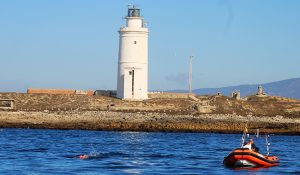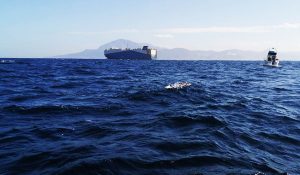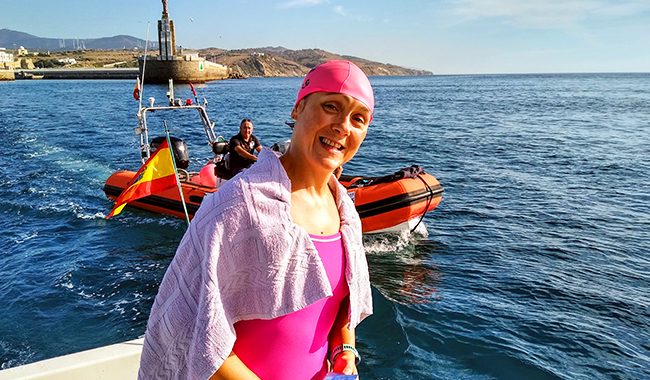Laura López Bonilla tackles the Gibraltar Strait
On October 29th, the Spanish swimmer and our member Laura López Bonilla completed the 16 km swim across the Gibraltar Strait in a time of 6 hours and 17 minutes. After completing the 20 Bridges Manhattan Swim in August, Laura had been waiting to complete this swim for a year after being ´weathered out’ in 2018 due to strong winds.
The Preparation
Laura had almost given up on being able to complete the swim this year due to the weather and was already thinking about re-booking it for the 2020 season. Laura said “I was spending the half term week in Madrid with my family, hoping to get the call to travel down south to Tarifa in Cádiz. Of course, this did not happen as the winds were blowing strongly from the East and the weather had been bad all over Spain the whole week. I was flying back on the Saturday when I got a message to say that the following Tuesday was a swim day. So I found myself checking in on a return flight to London, while booking a flight back to return to Spain on the Monday and then straight back to work teaching on the Thursday”.
She says” The reorganising and rearranging of traveling was manic and quite stressful, but experience has taught me that this last-minute call often happens in open water swims across channels, that are weather dependent. It is part and parcel of this crazy sport, but always a challenge to deal with”.
The day of the swim turned out to be a beautiful and warm day, sunny with light winds and very warm for late October. The air temperature was around 25ºC with light winds and calm seas. Laura got to the port where she was greeted by the boat pilots Antonio and his daughter Cristina. She also meet the pilots of the Rigid-hulled inflatable boat (rib) from where she would get her drinks and continuous support throughout the swim. The Gibraltar swim is organised through the Asociación para el Cruce a Nado del Estrecho de Gibraltar (ACNEG) and can take up to two years to arrange a booking to complete the swim.
The swim is between 14 and 16 km across in a diagonal line that starts right from the Spanish coastline and finishing left on the Moroccan side. The currents coming from the Atlantic that meet with the warm waters of the Mediterranean are very strong and can push swimmers from right to left. For an experienced marathon swimmer like Laura the distance was not long. Laura said “However due to strong currents, the main difficulty is to sustain a minimum speed of 3 km an hour consistently in order to be able to touch land before the turn of tide on the Moroccan coast around the 6 hour mark. The intensity of the swim physically and mentally is as strong as the currents you have to swim across”.

The Swim
The swim started off Isla Palomas on the coast of Tarifa and Laura could immediately feel the push of the currents as she was approaching the island, as she had to touch the cliff face to start of the swim. The water was warm at 20ºC, so she knew the water temperature was not going to be an issue. The lead boat was about 20 metres ahead with the rib boat about 2 or 3 metres away from either side of her.
Laura explained “During the first hour of my swim I found myself calming my nerves and trying to swim against a very strong cross Atlantic current. Many ferries and ships passed by and I got stung by a few jellies. Time seems to stop and speed up while you entertain yourself with any thoughts that don’t involve thinking too much about the task ahead or how far you have to go. After my first drink, the real battle began. This was a tough swim and I wasn’t too sure I was keeping up with the speed I needed to. I was wearing my Garmin watch that beeps every 500 metres, so I could keep some sort of track of the speed I was swimming at. I got a little bit discouraged and my heart just sank deep into the ocean. I was feeling a little unwell and a strong headache kicked in”.
Despite all her experience as an open water swimmer, Laura said “my head and my spirit started spinning in despairing turmoil and once the negative thoughts kick in, you have to regain control and focus even harder. All the stress of rearranging my traveling, being off school, having to deal with a chronic shoulder injury, the tiredness from the Manhattan swim, the strong currents and more jelly fish stinging me; all I could think about were excuses to give up. So I kept looking ahead and focused on the boat ‘Columba’, painted in pristine white, keeping to the colour of the meaning of its name, Dove, the symbol for peace”.
She continued “I desperately wanted to get back on the boat, climbing the short steps up that ladder and be safe and dry. But I did not want to be defeated and realised that the main reason I was scared, was of failing. I flicked the switch in my brain and realised that my desire for success was greater than my fear of failure. In order to focus, I spent the next two hours counting strokes up to 100, then starting again as I kept losing count. I have no idea how many 100 sets of strokes I counted. One, two, three, breathe to the right, four, five, six, breathe to the rib, seven, keep track of the lead boat 20 metres ahead, and so I continued this until the next feeding stop. Ironically, the more I counted, the better I got into a good pace and by the time I got my third feed I was told I was over halfway across and in Moroccan waters. With each stroke counted I found a way of punching the demons out of my head and regained the inner strength to swim on”.

The next hour for Laura proved to be challenging, the wind had picked up and was now a Force 3 on a spring tide with high seas. The swell coming from the West made breathing to that side hard and following the lead boat a little more challenging. The sun was now mid sky and gleaming into the water. She could see the African coastline very distinctly now and she knew that she still had to fight these currents with all her strength. Laura explained that she just kept thinking “how many chances you get in life to swim across two continents and that it felt really cool to be linking Europe and Africa with each stroke”.
Her injured shoulder starting to ache and Instinctively, she started to be more deliberate with her strokes in order to complete the swim. “By the time my next feed came along, I was told I only had 4 km left. Not far, and yet, still a long way to go with the tide about to change. By then, fatigue started to set in, shoulder and elbow aching and anguish set in again. I knew that if the tide changed, I would not be able to finish the swim. Being the end of October, we would be running out of day light and the tide would also be taking me off into the Mediterranean with no landing points, putting an end to the swim”.
Almost there and Laura saw the boat of the Moroccan Gendarmerie pass by. The Moroccan authorities checked her passport and made sure the swim was authorised and conducted by the Gibraltar Swim Association. Laura then heard Antonio shout to the rib pilots and he explained to them that the tide was turning. Laura said “I had to push hard to get into the bay adjacent to Punta Cires. Then, I started to see the bottom, the water was getting shallower, I could see white rocks about a metre underneath. This is always a very exciting moment on a long-distance swim. For hours, the swimmer sees nothing but a dark blue ocean, and as you start seeing the seabed, you know you are completing the swim. As I was approaching a rocky formation on the bay I scratched and cut my knees on the sharp rocks of Punta Almansa, one kilometre further east of Punta Cires. Then, I heard the whistle that signalled the end of the swim”.
Laura had swum with all the strength of her spirit and heart across the Gibraltar Strait and completed it in 6 hours, 17 minutes and 04 seconds. Amazing!!!

